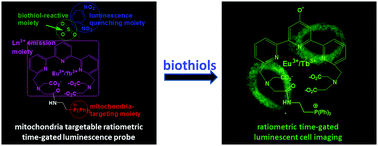当前位置:
X-MOL 学术
›
J. Mater. Chem. B
›
论文详情
Our official English website, www.x-mol.net, welcomes your feedback! (Note: you will need to create a separate account there.)
Development of a mitochondria targetable ratiometric time-gated luminescence probe for biothiols based on lanthanide complexes†
Journal of Materials Chemistry B ( IF 7 ) Pub Date : 2018-02-22 00:00:00 , DOI: 10.1039/c8tb00030a Xiangli Liu 1, 2, 3, 4, 5 , Bo Song 1, 2, 3, 4, 5 , Hua Ma 1, 2, 3, 4, 5 , Zhixin Tang 1, 2, 3, 4, 5 , Jingli Yuan 1, 2, 3, 4, 5
Journal of Materials Chemistry B ( IF 7 ) Pub Date : 2018-02-22 00:00:00 , DOI: 10.1039/c8tb00030a Xiangli Liu 1, 2, 3, 4, 5 , Bo Song 1, 2, 3, 4, 5 , Hua Ma 1, 2, 3, 4, 5 , Zhixin Tang 1, 2, 3, 4, 5 , Jingli Yuan 1, 2, 3, 4, 5
Affiliation

|
A mitochondria targetable ratiometric luminescence probe based on a mixture of Eu3+ and Tb3+ complexes, Mito-NSTTA–Eu3+/Tb3+, has been developed for the specific recognition and time-gated luminescence detection of biothiols in aqueous and living samples. This probe was synthesized by conjugating a mitochondria-anchoring motif, triphenylphosphonium, with a biothiol-responsive terpyridine derivative, [4′-(2,4-dinitrobenzenesulfonyloxy)-2,2′:6′,2′′-terpyridine-6,6′′-diyl] bis(methylenenitrilo) tetrakis(acetic acid), for coordinating with Eu3+ and Tb3+ ions. When the probe interacts with biothiols, the cleavage of the 2,4-dinitrobenzenesulfonyl moiety leads to a remarkable enhancement of the Tb3+ emission at 540 nm, while the Eu3+ emission at 610 nm is unchanged, which allows Mito-NSTTA–Eu3+/Tb3+ to be used as a ratiometric probe for the time-gated luminescence detection of biothiols, with the luminescence intensity ratio of I540/I610 as a signal. The triphenylphosphonium group enables the probe molecules to be specifically driven into the mitochondria after cell loading for responding to biothiols therein. Mito-NSTTA–Eu3+/Tb3+ showed high selectivity and sensitivity for the detection of biothiols under physiological conditions, with detection limits of 0.098 μM for glutathione (GSH) and 0.14 μM for cysteine (Cys). In cell imaging experiments, Mito-NSTTA–Eu3+/Tb3+ displayed an excellent mitochondria-localization feature, which allowed biothiols in the mitochondria of live cells to be successfully imaged under ratiometric and time-gated luminescence modes. In addition, biothiols in living Daphnia magna were also imaged using Mito-NSTTA–Eu3+/Tb3+ as a probe. All of the results suggested that Mito-NSTTA–Eu3+/Tb3+ could serve as a useful tool for monitoring biothiols in vitro and in vivo with high specificity and sensitivity.
中文翻译:

基于镧系元素络合物的生物硫醇线粒体靶向比例计量时间发光探针的开发†
基于Eu 3+和Tb 3+配合物Mito-NSTTA–Eu 3+ / Tb 3+的线粒体可靶向比例发光探针已经开发出来,用于水和水中生物硫醇的特异性识别和时控发光检测。活体样本。该探针是通过将线粒体锚定基序三苯基phosph与生物硫醇响应性叔吡啶衍生物[4'-(2,4-二硝基苯磺酰氧基)-2,2':6',2''-叔吡啶-6, 6'′-二基]双(亚甲基腈)四(乙酸),用于与Eu 3+和Tb 3+配合离子。当探针与生物硫醇相互作用时,2,4-二硝基苯磺酰基部分的裂解导致540 nm处Tb 3+发射显着增强,而610 nm处的Eu 3+发射未改变,这使得Mito-NSTTA- Eu 3+ / Tb 3+用作生物硫醇的时间门控发光检测的比率式探针,发光强度比为I 540 / I 610作为信号。三苯基phosph基团可使探针分子在细胞加载后被特异性地驱动到线粒体中,以响应其中的生物硫醇。水户NSTTA–Eu 3+ / Tb 3+在生理条件下检测生物硫醇具有很高的选择性和灵敏度,谷胱甘肽(GSH)的检测限为0.098μM,半胱氨酸(Cys)的检测限为0.14μM。在细胞成像实验中,Mito-NSTTA–Eu 3+ / Tb 3+表现出出色的线粒体定位功能,使活细胞线粒体中的生物硫醇能够在比例发光和定时发光模式下成功成像。此外,还使用Mito-NSTTA-Eu 3+ / Tb 3+作为探针对活水蚤中的生物硫醇进行了成像。所有结果表明,Mito-NSTTA–Eu 3+ / Tb 3+可作为监测生物硫醇的有用工具在体外和体内具有很高的特异性和敏感性。
更新日期:2018-02-22
中文翻译:

基于镧系元素络合物的生物硫醇线粒体靶向比例计量时间发光探针的开发†
基于Eu 3+和Tb 3+配合物Mito-NSTTA–Eu 3+ / Tb 3+的线粒体可靶向比例发光探针已经开发出来,用于水和水中生物硫醇的特异性识别和时控发光检测。活体样本。该探针是通过将线粒体锚定基序三苯基phosph与生物硫醇响应性叔吡啶衍生物[4'-(2,4-二硝基苯磺酰氧基)-2,2':6',2''-叔吡啶-6, 6'′-二基]双(亚甲基腈)四(乙酸),用于与Eu 3+和Tb 3+配合离子。当探针与生物硫醇相互作用时,2,4-二硝基苯磺酰基部分的裂解导致540 nm处Tb 3+发射显着增强,而610 nm处的Eu 3+发射未改变,这使得Mito-NSTTA- Eu 3+ / Tb 3+用作生物硫醇的时间门控发光检测的比率式探针,发光强度比为I 540 / I 610作为信号。三苯基phosph基团可使探针分子在细胞加载后被特异性地驱动到线粒体中,以响应其中的生物硫醇。水户NSTTA–Eu 3+ / Tb 3+在生理条件下检测生物硫醇具有很高的选择性和灵敏度,谷胱甘肽(GSH)的检测限为0.098μM,半胱氨酸(Cys)的检测限为0.14μM。在细胞成像实验中,Mito-NSTTA–Eu 3+ / Tb 3+表现出出色的线粒体定位功能,使活细胞线粒体中的生物硫醇能够在比例发光和定时发光模式下成功成像。此外,还使用Mito-NSTTA-Eu 3+ / Tb 3+作为探针对活水蚤中的生物硫醇进行了成像。所有结果表明,Mito-NSTTA–Eu 3+ / Tb 3+可作为监测生物硫醇的有用工具在体外和体内具有很高的特异性和敏感性。



























 京公网安备 11010802027423号
京公网安备 11010802027423号